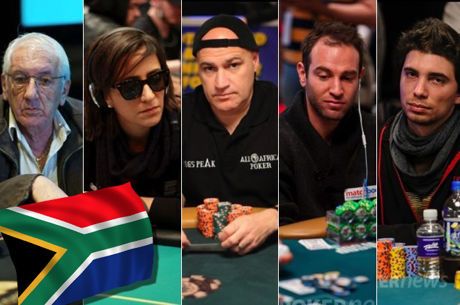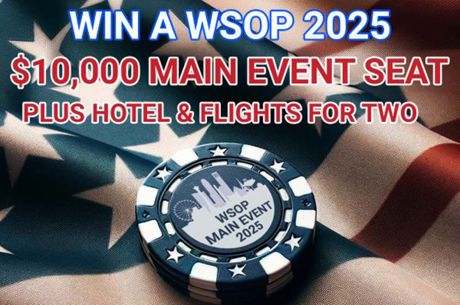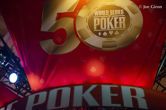TDA Summit Day 1: BBA, Dealer Narration, Chip Stack Etiquette and More

Table Of Contents
Poker is a complicated game that breeds complex situations, requiring sometimes intricate rules to govern the endless possible scenarios. To make sure those rules keep up with the evolution of poker, the Tournament Directors Association meets every other year to adjust and devise best practices for governing the game.
The 2019 TDA Summit, chaired by WPT Executive Tour Director Matt Savage, kicked off Friday morning in an ARIA conference room. TDs from far-flung locales like Japan and Brazil made the trip, with Savage and the rest of the TDA Board of Directors leading the discussion. Here's a look at the panel of directors present:
- Savage
- Neil Johnson
- Tab Duchateau
- Johnny Grooms
- Lloyd Fontillas
A few poker players were also in attendance. Most prominently, pro player Michael Gagliano figured into a few of the discussions, making sure players had a voice in the proceedings.
A number of industry topics were covered, ranging from big blind antes to how much of their faces players should be allowed to conceal.
Perhaps surprisingly for an industry that can be slow to embrace change — and sees plenty of public squabbling between even experienced veterans on key issues — near-consensus prevailed on many topics.
Many of those will be of prime interest to regulars, both recreational and professional alike. Changes to the TDA rules mean changes to the very fabric of the tournaments they grind, and being unaware of such changes can mean putting oneself in a precarious position should a relevant scenario arise.
Big Blind Ante
While the big blind ante has seemingly been an issue beaten to death and debated up, down and sideways in recent years, it's actually still a relatively new concept and wasn't widely in use the last time the TDA met, in 2017.
Whether or not to use big blind ante is no longer the main issue. That's been settled as it has proliferated to seemingly every tournament in the world. Exactly how best to implement it remains a thorny issue, one on which the industry has yet to come to a consensus.
Specifically, two main debates continue to exist. First, should the big blind or the ante be posted by a short-stacked player who can't afford both and is in the big blind? Second, should the consolidated ante be reduced in size when the table is short, emulating the lesser ante total at a short-handed table with traditional anteing?
Ante First or Big Blind First?
The panel first tackled the former issue. Kenny Hallaert, a professional-level competitor who nonetheless maintains a job as a TD in Europe, spoke up in favor of posting the big blind first, so players wouldn't win an all-in pot and be left sweeping up only the same ante they'd posted, effectively profiting zero.
That exact scenario, he argued, would leave a sour taste in the mouths of recreational players trying to run up their crumbs. To be friendlier to those players, Hallaert pushed for big blind first.
However, Hallaert proved to be heavily outweighed by those favoring antes first. One after another TD took the mic and made the case for antes first. For one thing, the ante has always come first in poker, as many people pointed out over the years.
That's in the very definition of the word, pointed out Grooms, director of poker at MGM National Harbor in Maryland.
"Literally, the word ante means before," he said.

Duchateau said he understood the argument that some didn't want to punish short stacks, but he couldn't see that as being strong reasoning compared to the other side.
"Do you want to be friendly or do you want to be logical?" he asked. "That's what this comes down to."
Perhaps the most convincing argument came from ARIA TD Paul Campbell. A top TD unafraid to experiment — he was the first adopter of the big blind ante — Campbell stressed that it wasn't about punishing short stacks but rewarding those who entered pots.
After all, the essence of tournament poker is forced action stemming from rising blinds, and allowing players to wait it out and then multiply their stack many times when all in from the big blind contradicts that very nature.
"We should be rewarding aggressive play," he said. "We should be rewarding chip accumulation. [With big blind first], you are encouraging players not to play poker."
Support for ante first was nearly unanimous.
Reducing Antes at Short Tables
Not quite unanimous, but still overwhelming, was support for keeping the size of the big blind ante the same regardless of the size of the table.
Savage, a staunch advocate of not reducing the ante size, pulled from the same points Campbell made. Keeping the ante a little larger, he pointed out, creates more action. More players bust out, creating a deeper-stacked tournament for those who are still in.
A few TDs said they remain in favor of reducing. They argued it more closely resembles the size of the antes when using traditional anteing.
As a counter, Hallaert and Savage said that the players are usually putting in less antes per orbit at a full table, which will be happening for most of the tournament. For example, Hallaert outlined the old 1,200/2,400/400 level. Players would put in 3,600 in antes during a nine-handed orbit at this level, whereas with big blind ante they're only putting in 2,400.
The vast majority stood behind Savage in not reducing, and a couple of representatives even floated formats with larger consolidated antes. Iori Yogo, an experienced pro from Japan, said he has played in a format with an ante that was twice the size of the big blind. Ben Erwin of Thunder Valley in California said his room runs "Action 8" tournaments with eight-handed tables and antes from the start equal to a big blind plus a small blind.
Yogo argued that such formats are good for the poker economy. Strong pros, he maintained, would still have great win rates, while many of the pros employing nittier styles would lose some of their edge as they were forced to gamble more with recreational competitors.
Bet Announcements
One of the most controversial topics for players will likely be question of whether dealers should announce bet sizes as they're placed. Traditionally, dealers have been told to only announce "bet" or "raise" and specify amounts when receiving a request from a player whose turn it is to act.
Savage said he believed having dealers announce every sizing would speed the game up a bit, but he wasn't all in on his viewpoint and was open to being convinced otherwise. Immediately, a few TDs spoke up in support of announced bets.
Savage said he believed having dealers announce every sizing would speed the game up
A TD from Aspers in the U.K. pointed out announcing bets would keep the dealers more engaged and less prone to mistakes stemming from lapses in focus. Campbell said it would do the same for players and cut down on mistakes and floor calls that would slow the game.
Duchateau, playing devil's advocate, asked if anyone was worried about more dealer mistakes. A few around the room nodded, but Justin Hammer of Commerce in L.A. was the only one strongly opposed.
In the end, nearly everyone agreed that the best way would be for dealers to announce the size of bets and raises but keep to simply "all in" for all-in wagers. A handful remained opposed, including one TD who opined that he didn't want people to know his bet amounts, but it appears this may come into the TDA ruleset as a recommended procedure, pending further discussion.
Chip Stacking — Forced 20s?
Another topic that may strike some nerves around the poker world was whether players should be forced to stack their chips in towers of 20 or if some leniency could still be in place to allow for a bit of personal preference and creativity.
Hallaert and Savage appeared to be leaning toward forced 20s, stemming from a tweet by Hallaert that caught Savage's attention when a player splayed out all of his chips one by one.
Should this really be allowed? @PokerTDA Summit next week @ARIAPoker. https://t.co/hqtUojB367
— Matt Savage (@SavagePoker)
Hallaert said forced 20s would speed the game up and reduce mistakes from all parties.
Duchateau wondered what response TDs would have if a player refused to stack in 20s.
"I'd tell him, 'Sir, you're going to sit out until your chips are in stacks of 20,'" Hallaert said.
Johnson pointed out that while everyone would stack in 20s in a perfect world, it harkened back to when his old employer, PokerStars, tried to ban electronics from the table. It turned the dealers into "police," he said, and produced animosity between players and exasperated staff members simply trying to enforce rules as they were instructed.
"Sir, you're going to sit out until your chips are in stacks of 20"
Agreeing the pushback on forced 20s might be too much, Savage wanted to find a middle ground with language about "manageable, countable stacks."
"I don't know how much farther we can go on this," he said.
In the end, the issue appeared to be tabled for further discussion.
Other Odds and Ends
Outside of those major topics, a number of other points were hit across the six hours or so spent in the conference room.
Perhaps most impactful was an agreed-upon change to the number of players who make a final table. Currently, many situations with two tables remaining play with unbalanced numbers. The most obvious example comes when 11 players remain with a plan to combine at 10. One table plays five-handed and the other six-handed.
Savage pushed for a change to nine-handed final tables, while remaining at seven-handed tables for six-max events and the like. For one thing, he said, it's more fair for the players to be balanced so one table isn't having the blinds sweep through them more often. For another, it produces more action at two tables of five than one table of 10.
The most obvious downsides examined were one less player making a final table and getting the excitement and pride that comes from that, and taking longer to open up a table for smaller rooms that need it for cash action.
While almost everyone agreed playing longer at two tables was superior, the latter point against just carried too much weight for TDs in small rooms. It was agreed that nine-handed and seven-handed would be recommended procedures but not hard and fast rules.
One thing the entire room full of TDs agreed upon was elimination of two-motion raises. The consensus was that a player should have to put the entire raise into the pot in one motion, rather than placing calling chips in and then opting for a raise amount. While acknowledging this would take some re-training, the new ruling will be that such a motion constitutes a min-raise.

Another topic that poker Twitter has had a bit of back-and-forth on was addressed as well: players completely covering up their faces to avoid giving away any reads.
Savage fired in a few slides of players concealing their faces, with one notable example showing a player clad in a black motorcycle helmet. General agreement was that there's a reasonable limit, and it was decided that wording a rule with something like "floor staff must be able to identify a player at all times" should be used.
A final major topic was only briefly touched on, but it's been catching some buzz lately with Hallaert recently railing against the current state of late registration. No consensus on anything regarding this was reached, though Savage did hint he agrees with Hallaert.
One TD suggested those in their seats for the start of play get a very slight chip stack boost, but the issue seems to be tabled for further discussion in the coming days. PokerNews will have more on the matter from Hallaert himself and possibly the second day of TDA Summit.









